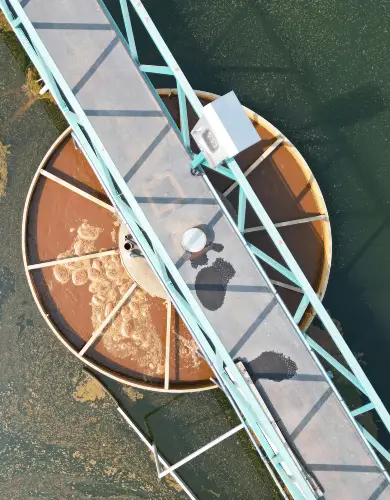Hydroelectric Power in Britain
Approximately 2% of the electricity generated in Britain comes from a fleet of ageing hydroelectric dams.
Although hydroelectric power offers a very cheap renewable energy source, the scope for building more dams is extremely limited due to Britain’s geography.
In contrast, Pumped Hydro Storage plants play a crucial and growing role in providing a power reserve to balance the intermittent electricity produced by solar and wind farms.
This article explains the role of hydroelectric power in the British energy industry and its future as we transition towards net-zero. Here’s what we cover:
- What is hydropower?
- How does hydropower work?
- Hydroelectric Power Stations in Britain
- Pumped-Storage Hydroelectric Plants in Britain
What is hydropower?
Hydropower is the process of harnessing the flow of water to produce sustainable energy.
The simplest form of hydropower originated in Ancient Greece, where a water wheel generated power for grinding grain. Today, hydropower is the single largest renewable energy source, with over 20,000 stations operating worldwide.
Large hydroelectric plants, such as the Hoover Dam, generate a very cheap source of electricity without producing greenhouse gases.
Hydroelectric power is both carbon-neutral and renewable, as it relies solely on the water cycle for energy rather than fossil fuels.
How does hydropower work?
The hydroelectric dam is the most common type of hydropower station. A dam is constructed across a river, creating a reservoir by backing up the water. Once filled, the reservoir behind the dam is much higher than the river in front.
Water from the upper dam is then released to drive a turbine which produces electrical energy.
The hydropower process converts the naturally occurring kinetic energy in rivers into electricity.
Another form of hydroelectric generation is a run-of-river plant, which does not require a dam and simply uses the energy of a fast-flowing river to drive turbines.
Hydroelectric Power Stations in Britain
Hydroelectric power stations contribute approximately 2% to Britain’s power generation. This is ten times less than the energy currently produced by UK wind farms, which continues to grow each year.
Britain’s geography severely limits its potential for hydroelectric power generation. There are only a few mountainous areas and shorter, less powerful rivers compared with other countries.
All of Britain’s biggest hydroelectric dams were built over 50 years ago on sites in the mountainous regions of Scotland and Wales, which are suitable for hydroelectric power.
The power generated from these hydroelectric dams is highly predictable, providing baseload power for the Scottish electricity distribution network.
Here is a breakdown of the five hydroelectric power plants with the largest power output in Britain.
| Power Station | Commissioned | Location | Type | Capacity (MW) | Owner |
|---|---|---|---|---|---|
| Sloy | 1950 | Loch Lomond, Scotland | Conventional dam | 152 | SSE Renewables |
| Glenlee | 1930 | Glenlee, Scotland | Run-of-river hydro | 103 | Drax Group |
| Clatteringshaws | 1930 | Clatteringshaws Loch, Scotland | Series of conventional dams | 40 | Drax Group |
| Mossford | 1950 | Strathfarrar, Scotland | Cascade hydro | 36 | SSE Renewables |
| Rannoch | 1930 | Loch Rannoch, Scotland | Natural reservoir | 44 | SSE Renewables |
Each of these large-scale dams is owned by business energy suppliers. The renewable energy they generate is registered under the Renewable Energy Guarantees of Origin scheme and is used to supply green energy tariffs.
💡 Use our business energy comparison service to find the cheapest green tariffs. Our business energy experts have helped thousands of companies switch business energy suppliers.
Pumped-Storage Hydroelectric plants in Britain
Pumped Storage Hydro (PSH) plays a critical role in the British energy industry by acting as giant batteries, which can be called upon at any time to provide additional power and balance supply and demand on the grid.
PSH plants store water at an elevated height, which can be released when needed to generate electricity. This makes them a large-scale energy storage solution that supports intermittent renewables.
Pumped hydro plants can go from standby to full power generation within seconds.
Pumped hydro storage plants are the largest energy storage source on the national grid. Here is a summary of the five largest-capacity pumped storage sites in Britain.
| Power Station | Commissioned | Location | Capacity (MW) | Owner |
|---|---|---|---|---|
| Dinorwig | 1984 | Snowdonia, Wales | 1,728 | First Hydro Company |
| Cruachan | 1965 | Loch Awe, Scotland | 440 | Drax Group |
| Ffestiniog | 1963 | Gwynedd, Wales | 360 | First Hydro Company |
| Foyers | 1974 | Loch Ness, Scotland | 300 | SSE Renewables |
| Tongland | 1935 | Dumfries & Galloway, Scotland | 33 | Drax Group |
Unlike conventional hydroelectric dams, there are plans for significant expansion of pumped hydro in Britain to support the growing role of intermittent renewables.
One prominent example is Coire Glas in the Scottish Highlands, where SSE proposes building a 1.3 GW plant.
British water companies generating hydro power
Hydroelectric power generation is also being adopted by the British water industry, which already has large reservoirs that store drinking water.
One prominent example is Scottish Water, which has built 28 hydroelectric schemes at its reservoirs across Scotland.
United Utilities (the water infrastructure provider for North West England) generates 2 GWh of electricity a year from its hydroelectric power plant at Oswestry.
This water company uses the electricity generated on-site to power a sewage treatment works and also exports excess electricity back to the local grid using the Feed-in Tariff scheme.
The carbon emissions associated with water in Britain are high, and generating renewable hydropower is an effective way to reduce carbon intensity and the environmental impacts of the water industry.
At AquaSwitch, we help businesses get more from their water supply, including becoming more environmentally friendly. We help companies to compare business water suppliers, including those that offer green tariffs. Compare the market and switch business water supplier today.

